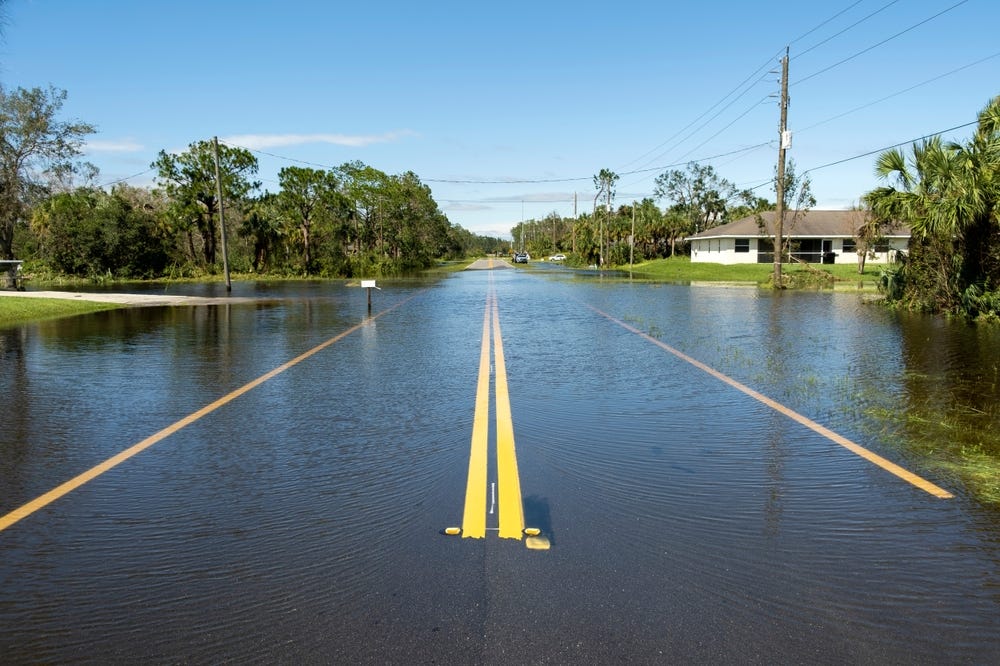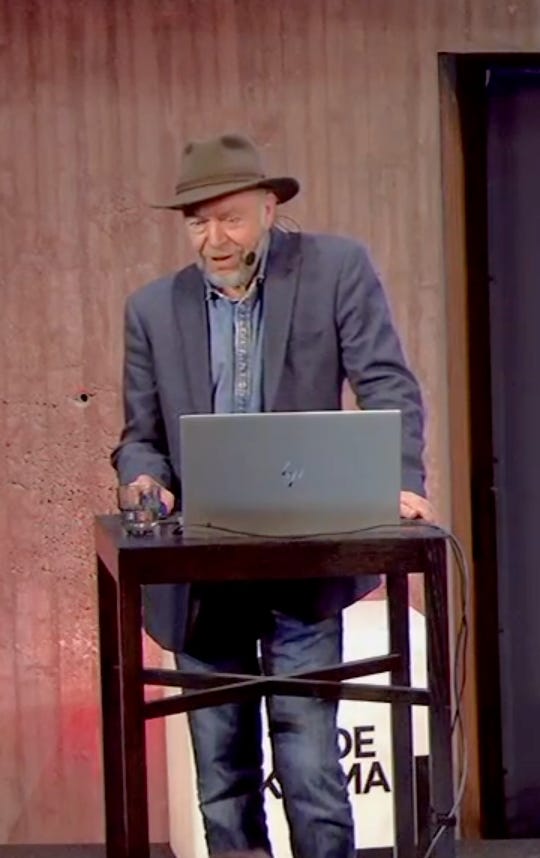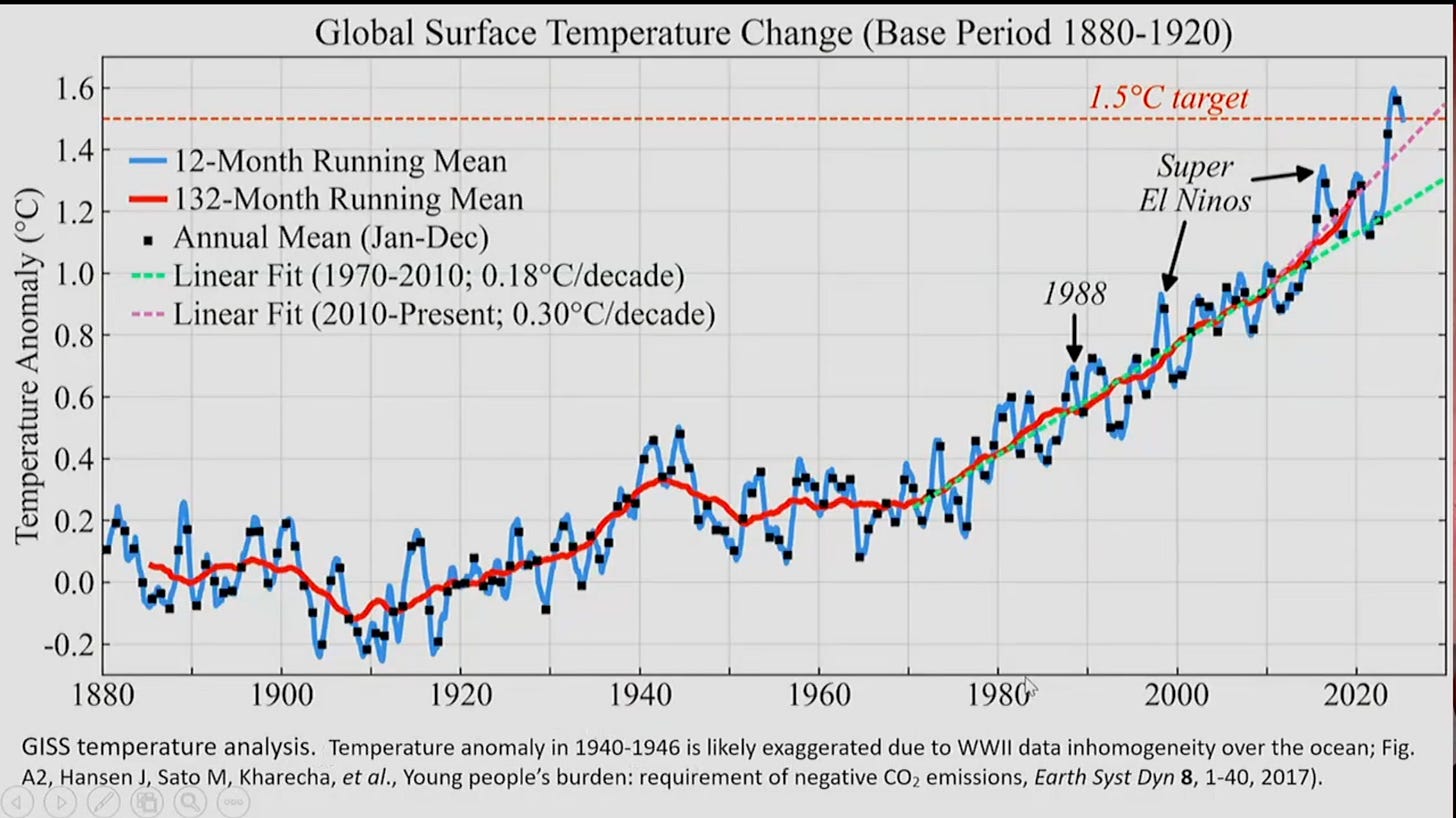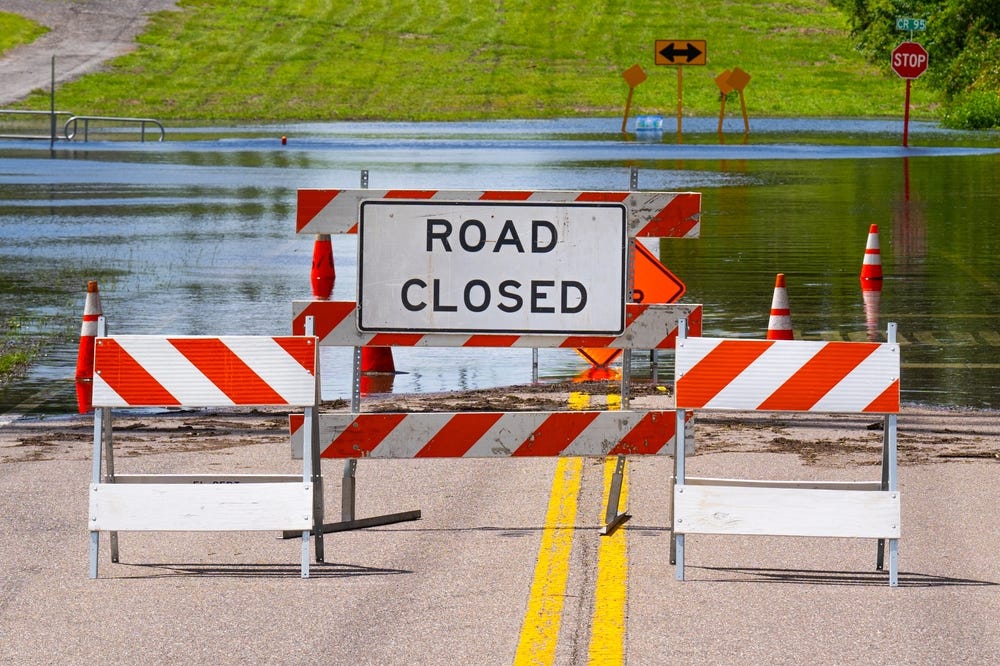James Hansen is trying to get a message across
Young investors are advised to take risks and stay the course. They need some real talk about the risks of climate change — to coastal cities, to the economy, and to their futures
Today’s market turbulence prompts advice to young investors: Stay the course. You’ve got time. The stock market, over any long-term period, will aways reach new highs. Mike Mers, Founder of Aspen Capital Management, said recently that he advises people under 30 not to worry about market volatility:
I want ‘em owning higher risk, higher expected return assets like global equities.
For me with my kids, it’s Hey, let’s go buy a really broadly diversified low cost global equity fund. We’re not worried about volatility. This is money that’s in retirement accounts that we can’t touch for decades. So let’s not worry about volatility, let’s just try to maximize our long-term returns. So a hundred percent equities.
What is unimaginable for many people is that the risks posed to coastal cities by global warming will only accelerate in the decades to come. We are already seeing increased flooding and intensifying storms, Those cities will not bounce back on any human timescale. Common “things happen in cycles” thinking is not helpful in the context of the physical risks of climate change, particularly for young people. But no one is very good at making this clear to the general public—including the young.
James Hansen, the scientist who first brought global warming to the world’s attention in 1988, wants older generations to communicate clearly about this increasing risk to young people. Late last month, at a talk in Finland, he tried to get out a message. Here it is, paraphrased:
Reticent scientists have systematically underestimated the risk of large levels of sea level rise. Why? It turns out that Earth’s physical systems are much more responsive to small changes in carbon dioxide or sunlight than projections from the Intergovernmental Panel on Climate Change (IPCC) assume. (They’re not looking at all the evidence.) It also turns out that until recently, aerosols sent out by ships hid the planet’s true warming underneath an artificial cool fog. So climate change will accelerate more quickly and with greater effects than current projections suggest, because more heat than we think is already locked in and will need to be released. We’ve already seen accelerated warming since 2010—an unusually sharp ~0.4°C rise in just a few years.
After 2040-2050, as sustained global temperatures reach and exceed 2 degrees over preindustrial times, we’ll see Greenland and Antarctica melting more quickly than we now assume. Both heat from above and warm water from below will eat away at ice shelves—which will mean a layer of fresh meltwater will be sitting in the North Atlantic. That layer of freshwater will frustrate a basic circulation that runs behind our climate—so Europe will get much colder and the East Coast of the US will get even more storms and even more flooding. At the same time, all the water around the world will be taking up more space as it heats up. Both melting icebergs and expanding seawater will lead to increasingly catastrophic levels of flooding, possibly multimeter sea level rise by 2100, wildly heavier rainstorms, and general misery for coastal cities.
Here’s how I learned about the message that James Hansen is trying to get across. A few weeks ago, I was lucky to meet with some atmospheric climate scientists in Boulder, at NCAR’s Research Applications Lab. I asked several of them if they respected Hansen and Stefan Rahmstorf, two scientists I follow closely. Everyone I asked unhesitatingly endorsed both people. Then, last week, I got a blast email from Hansen with a link to his latest half-hour presentation. I spent more than five hours this week puzzling through what he said, looking terms up and studying his slides. Then I did my best to summarize for you what he said. This process took effort. I needed to find out whether I should trust Hansen and I needed to dig slowly through his dense presentation.
James Hansen, October 2025
The trouble is that James Hansen himself speaks carefully—he’s a scientist!—and uses many terms that an ordinary newspaper reader doesn’t know. Even his clearest, most dramatic statements require interpretation. For example, here’s what he said at the beginning of his talk:
Climate change is characterized by delayed response and amplifying feedbacks, which are a recipe for intergenerational injustice. So we have an obligation to clarify this and to not shirk from describing the implications.
Climate sensitivity is the most basic issue.
Well, does everyone understand “amplifying feedbacks”? How about “climate sensitivity”? Perhaps you do. Many do not.
Hansen’s point is that many sources of scientific insight (including temperature data, historical data, and information about clouds and the Earth’s darkening) tell him that the climate will react with heated ferocity—far higher temperatures than the IPCC’s consensus range—to the thickening blanket of carbon dioxide surrounding the Earth. Fewer, thinner, and less bright clouds are letting in torrents of heat from the sun, which amplifies the heating already happening as a result of that blanket. There are a lot of unexpected, amplified reactions that the IPCC isn’t looking at adequately, according to Hansen. The net result: Much more warming is ahead, soon, and it will have outsized impacts, particularly on global coastal cities. Here’s the chart showing accelerated warming recently:
And it’s headed higher, quickly.
Hansen says:
The RCP 2.6 scenario, which was designed to keep warming under two degrees, is now impossible. We are closer to RCP 8.5.
That’s dramatic! But would a reader along the East coast understand why? He means that we have made little progress reducing emissions, and we’re following the worst case scenario dreamt up by the IPCC. Which means hugely destructive effects on lives worldwide.
Hansen says “Greenhouse forcing is increasing at the astounding rate of almost half a watt per decade.“
That’s serious! He means that the equivalent energy used by tens of thousands of New York Cities per hour, combined, is being absorbed every second by every part of the entire planet.
Why does this matter? Because two degrees of warming—where we’re headed later in this century because of this massive heating—will have huge effects on the ocean currents that frame our climate and shape our shores. Because this amount of warming will lead to multi-meter sea level rise within a matter of decades, and that will have enormous effects on the lives of the youngest among us and their children and grandchildren. They need to plan ahead to live in different places and in different ways.
It is not James Hansen’s job to boil down his points into tractable sound bites. But unless there are trusted leaders of all ages, active in political or cultural or sports-league or entertainment circles, who understand these risks and are willing to talk about them, communicating these things to younger people won’t happen. Jim Hansen’s overriding goal, it seems, is to make sure this somehow takes place. Here’s the clear gist of his presentation: “Young people need to be honestly informed about the situation and how old people screwed up.“
Surely someone—many someones—should take him up on this. Financial advice is everywhere these bearish days. Climate advice requires a different mindset—but it’s just as necessary.







The deeper question with climate is, why would well-educated people consent? It's never been a lack of info, even preceding Hansen's testimony in 1988. This White House memo, visualizing 10' of sea level rise wiping out New York City, is from 1969, and Moynihan went on to represent NY in the Senate:
https://www.nixonlibrary.gov/sites/default/files/virtuallibrary/documents/jul10/56.pdf
A good gauge of what's actually happening with climate is Eric Schmidt, former CEO of Google, who is now all in on AI:
https://www.tomshardware.com/tech-industry/artificial-intelligence/former-google-ceo-says-climate-goals-are-not-meetable-so-we-might-as-well-drop-climate-conservation-unshackle-ai-companies-so-ai-can-solve-global-warming
Schmidt and his wife helped launch Climate Central, which has done nothing but an excellent job detailing sea level rise with projections since 2008:
https://en.wikipedia.org/wiki/Climate_Central
You literally cannot be better educated on sea level than Eric Schmidt. That's not the problem. Getting America's high school valedictorians off this pipeline would be great:
https://www.sciencedirect.com/science/article/pii/S0921800914000615
At the moment, they're busy applying to Princeton (Schmidt's alma mater) so they can hopefully get in on the AI bubble, or at the least get to Goldman or McKinsey.
It's a long shot but it's possible that even valedictorians can take a chance on democracy, too:
https://drive.google.com/file/d/1LEAC20RbBIxw803QN88muaG37LT-8Vt_/view?usp=sharing
In any case, thanks for spelling things out!
We have no time. It’s up. No sugar coating it. For years I’ve been watching moderates try to lighten the message. But I always listened to James Hansen. It’s now time to mitigate the impacts. Of species loss and population growth too. If ever there was a time for the planet to come together, it’s now.